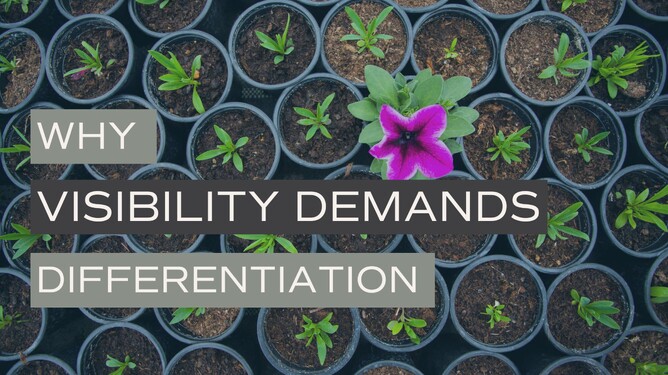How to create messaging that stands out in 2025
You’ve heard it a hundred times: just be consistent, just show up, just post more often.
But here’s the truth: visibility without differentiation is just noise. And in an online world where everyone is ‘showing up,’ being seen isn’t actually enough.
If your message blends into the background, it doesn’t matter how often you post. You could have the best product, the most insightful or entertaining content, and a wealth of experience, but if your brand positioning isn’t clear (overused phrases, vague positioning, or surface-level advice; you know the kind of content I’m talking about), your audience might drop you a ‘like’ but then scroll on past.
That’s why the real challenge isn’t just visibility, it’s being memorable.
There are probably just a few people you could think of who actually:
✔️ Have a clear point of view
✔️ Speak with a distinct voice
✔️ Stand for something beyond just ‘selling’
This is the power of differentiation. It’s not about shouting the loudest or being the most visible, it’s about saying something that actually lands with the right people.
The 4 core elements of a differentiated brand message
1. Your perspective: The thing only you can say
Your perspective is your superpower. It’s the way you see your industry, the insights you have, and the beliefs you stand behind. But most solopreneurs shy away from fully owning their perspective because they fear being polarising.
But differentiation requires boldness. The brands that stand out are the ones that have something distinct to say.
Ask yourself:
✅ What’s the status quo in my industry/profession, what is my vision for a better future (one my clients are also seeking) and how does my work make it a reality?
✅ What are my clients searching for, and what knowledge/perspective/experience do I have that will help them?
✅ What’s a belief I hold that isn’t talked about enough?
The key here is to move past safe statements and dig into what makes your perspective powerful.
Ways to communicate your perspective:
Storytelling – Share personal experiences that shaped your views.
Opinion pieces – Write about industry myths, challenges, or outdated advice.
Analogy & metaphor – Use creative comparisons to explain your unique take on things in new ways.
2. Your language: The way you say it matters
Your voice is as much a part of your brand as your visuals or your offers. Even if two people have the same perspective, how they say it can completely change how it's received. Your brand voice is what makes your message feel unmistakably you. The way you phrase things, the rhythm of your writing, and your choice of words create a signature style that makes your content recognisable.
If you’re unsure, look at your writing and highlight any phrases that could belong to anyone. Then, rewrite them in a way that feels more natural, more specific, and more you.
Ask yourself:
✅ How do I speak in real life? Is my writing capturing that tone?
✅ If I stripped my name from my content, would people still recognise it as mine?
✅ Am I writing how I think I ‘should’ sound, or how I actually sound?
Many solopreneurs fall into the trap of ‘polishing’ their voice too much. The result? Bland, corporate-sounding content that feels like it could belong to anyone.
To develop a more distinctive voice:
Ditch the jargon: Industry buzzwords and overused terminology make your content forgettable. Swap them for real, human language that your audience would naturally use.
Create and use your own signature phrases: Create your own distinct vernacular with certain words or ways of phrasing things that make your brand instantly recognisable. Own them!
Define and embrace your personality: Define a brand tone of voice that feels sustainable to you - it will only work if you can use it consistently, so choose personality traits that feel true to you as a brand.
3. Your positioning: Clarity over complexity
The fastest way to make your messaging stronger is to make it simpler. If someone lands on your website or social media and they can’t immediately understand:
Who you help
How you help them
Why you’re different
…you have a messaging problem.
A great positioning statement should be clear enough that your ideal client instantly recognises themselves in it. Good positioning is simple and specific. The clearer your message, the faster people will recognise why they should work with you.
A simple and effective structure for a positioning statement should clearly communicate:
Who you help (your target audience)
What problem you solve (their key pain point or challenge)
How you solve it (your unique method, approach, or offer)
Why it’s different (your unique value or differentiator)
It can be as simple as:
I help [target audience] who struggle with [key problem] by [your unique solution]. Unlike [status quo], I [your unique differentiator].
4. Your relatability: Making people feel seen and understood
Here’s what I know to be true: if people feel like you ‘get’ them, they’ll listen to you over someone else—even if that person is more experienced or better qualified. If people don’t feel seen, heard, or understood by your brand, they’ll keep scrolling.
Build relatability into your messaging:
✅ Speak to specific struggles: Use what you know (through customer and Voice of Customer research) to use specificity when talking about action-triggers, challenges, needs and motivations of your intended audience.
✅ Use their language: Pay attention to the exact words your audience uses in comments, emails, or testimonials—and mirror that in your messaging.
✅ Share your own journey: Show people that you’ve been where they are. Good messaging allows your audience to identify something in YOU that connects with who THEY are (or what they want or need) be evoking an emotional response.
Ask yourself:
What struggles or desires do my clients have that align with my own journey?
What values, beliefs and emotions do I share with my audience that can create deeper connection? (and where have these been significant in shaping my own journey?)
What emotions do I want my audience to feel when they hear my story?
Claim Your Lane
The first three actions I recommend from here?
✔️ Audit your messaging – Look at your website, LinkedIn bio, and recent content etc. Does it sound distinct, or could it belong to anyone?
✔️ Identify industry clichés – What are the most overused phrases in your field? How can you flip them or bring a fresh take?
✔️ Get bolder – The more specific and opinionated your messaging is, the more it will stand out. The solopreneurs who really claim their own their lane in 2025 will be the ones who win. Not the loudest. Not the most polished. But the clearest, boldest, and most themselves.
AND if you really want to go from invisible to unignorable?
If you’re tired of feeling like the best-kept secret in your industry, it’s time to Claim Your Lane. Visibility alone isn’t enough—you need a brand message that makes you an unignorable choice for your ideal clients.
Claim Your Lane is a brand mentorship experience for women who are the face of their service-based brand and are ready to stop blending in and start leading. Through guided support, you’ll:
✔️ Gain absolute clarity on what makes you unique and how to position yourself with confidence.
✔️ Craft messaging that feels effortless and true—so you always know what to say and how to say it.
✔️ Turn your story into your most valuable asset, connecting with the right clients and opportunities.
✔️ Finally feel seen and recognised for the expertise you’ve built over years of experience.
If you’re done playing small and ready to own your distinct space in the industry 👉 Join the waitlist for Claim Your Lane (launching soon!).

